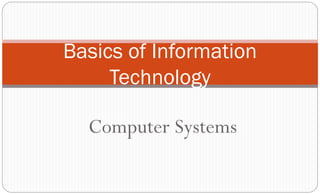
1.basics of information technology
- 1. Computer Systems Basics of Information Technology
- 2. WHAT IS A COMPUTER? Computer is an electronic device which is used to store the data, as per given instructions it gives results quickly and accurately. Data : Data is a raw material of information. Information : Proper collection of the data is called information.
- 3. Characteristics of a computer SPEED : In general, no human being can compete to solving the complex computation, faster than computer. ACCURACY : Since Computer is programmed, so what ever input we give it gives result with accuratly. STORAGE : Computer can store mass storage of data with appropriate formate. DILIGENCE : Computer can work for hours without any break and creating error. VERSATILITY :We can use computer to perform completely different type of work at the same time. POWER OF REMEMBERING : It can remember data for us. NO IQ : Computer does not work without instruction. NO FEELING : Computer does not have emotions, knowledge, experience, feeling.
- 4. Computer and its components Computer : Computer itself a combination of different type of separate electronic device. i.e. Computer only will be computer if it has INPUT DEVICE, PROCESS UNIT, and OUTPUT DEVICE
- 5. Input device Input device enables the user to send data, information, or control signals to a computer.
- 6. Output Device An output device is any piece of computer hardware equipment which converts information into human-readable form.
- 7. CPU-Central Processing Unit The CPU is the primary component of a computer that processes instructions. It runs the operating system and applications, constantly receiving input from the user or active software programs. It processes the data and produces output, which may stored by an application or displayed on the screen. It is known as the brain of computer.
- 10. An arithmetic-logic unit (ALU) is the part of a computer processor (CPU) that carries out arithmetic and logic operations on the computer. In some processors, the ALU is divided into two units, an arithmetic unit (AU) and a logic unit (LU). The control unit (CU) is a component of a computer's central processing unit (CPU) that directs operation of the processor. It tells the computer's memory, arithmetic/logic unit and input and output devices how to respond to a program's instructions. Registers are a type of computer memory used to quickly accept, store, and transfer data and instructions that are being used immediately by the CPU.The registers used by the CPU are often termed as Processor registers.
- 11. Computer - Memory A memory is just like a human brain. It is used to store data and instructions. Computer memory is the storage space in the computer, where data is to be processed and instructions required for processing are stored. The memory is divided into large number of small parts called cells. Each location or cell has a unique address. Memory is primarily of three types − Cache Memory Primary Memory/Main Memory Secondary Memory
- 12. Cache Memory- Cache memory is a very high speed memory which can speed up the CPU. It acts as a buffer between the CPU and the main memory. It is used to hold those parts of data and program which are most frequently used by the CPU. Primary Memory (Main Memory) - Primary memory holds only those data and instructions on which the computer is currently working. It has a limited capacity and data is lost when power is switched off. It is divided into two.RAM and ROM. Secondary Memory - This type of memory is also known as external memory or non-volatile. It is slower than the main memory.These are used for storing data/information permanently. CPU directly does not access these memories, instead they are accessed via input-output routines.The contents of secondary memories are first transferred to the main memory, and then the CPU can access it. For example, disk, CD-ROM, DVD, etc.
- 13. RAM (Random Access Memory) RAM (Random Access Memory) is the internal memory of the CPU for storing data, program, and program result. It is a read/write memory which stores data until the machine is working. As soon as the machine is switched off, data is erased. Also known as volatile memory. i.e. data stored in it is lost when we switch off the computer or if there is a power failure.
- 14. ROM (Read Only Memory) It is the memory for which we can only read but cannot write on it. This type of memory is non-volatile. The information is stored permanently in such memories during manufacture. A ROM stores such instructions that are required to start a computer. This operation is referred to as bootstrap.
- 15. Memory unit is the amount of data that can be stored in the storage unit. This storage capacity is expressed in terms of Bytes. The main memory storage units 1Bit (Binary Digit)- A binary digit is logical 0 and 1 representing a passive or an active state of a component in an electric circuit. Nibble-A group of 4 bits is called nibble. Byte- A group of 8 bits is called byte.A byte is the smallest unit, which can represent a data item or a character.
- 16. Kilobyte (KB) 1 KB = 1024 Bytes Megabyte (MB) 1 MB = 1024 KB GigaByte (GB) 1 GB = 1024 MB TeraByte (TB) 1TB = 1024 GB PetaByte (PB) 1 PB = 1024TB